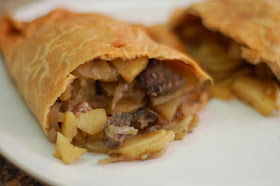Thai coconut ice cream is one of my favourite Thai food discoveries. Most days on my walk home from the BTS station after a long day at work I pass a street vendor selling this treat with all the various, uniquely Thai toppings such as sticky rice, roasted peanuts, corn and all sorts of candied sweet-bits. I have to muster all my will power to not indulge every day!
Whenever I discover something I've not had before I have a real desire to figure out how I can make it for myself. I take great satisfaction in this process so after much searching on the internet I've come up with this recipe for a Thai-style coconut ice cream. I make no claims that this is an authentic method but it is pretty tasty and with a deliciously creamy texture. If you can get hold of it, you should try serving with some cold sticky rice on top and some roasted peanuts. It seems like an odd idea to Western tastes at first but it really works, I promise!
Thank you to She Simmers for the inspiration with this recipe. That website is an endless inspiration for all my Thai food experimentations at the moment. Check out the She Simmers ice cream recipe here.
3 cups full fat coconut milk
2 teaspoons unflavored gelatine powder
2 tablespoons cornflour
1 3/4 cups of sweetened condensed milk (I used a 388ml can)
generous pinch of salt
- Mix the coconut and condensed milk together in a large sauce pan. In a small bowl blend the cornflour with a little of the milk mixture until you get a smooth paste then stir through the rest of the milk and add the powdered gelatine and salt.
- Put the pan over a medium heat and bring to a gentle boil, whisk regularly until the cornflour and gelatine is fully dissolved.
- Remove from the heat and place over an ice bath while giving it a good whisk to speed up the cooling down process.
- Once the mixture has cooled pour the mixture into an ice cream machine if you have one and churn it according to the manufacturer's instructions.
- If like me you don't own an ice cream machine all is not lost. Pour the mixture into a freezable container with a lid and pop the cooled mixture into the freezer for about 30 minutes. After it's been in there for a while, scrape the mixture into a large bowl, give it a good beating with a whisk then pour it back into the box. Repeat this process 3 to 5 times or until it is frozen throughout and has a creamy consistency without any large ice crystals.
- Serve however you wish. It's great in a Thai style ice cream sandwich with brioche style bread or topped with roasted peanuts, chopped up water chestnuts, dates and some sticky rice. Whatever takes your fancy.













